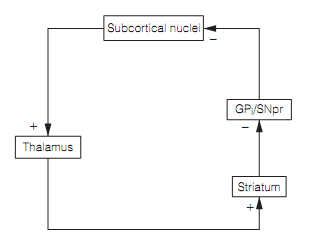Basal ganglia operation
One of the functions of basal ganglia is to allow the execution of motor series. Each series is presented by an array of cells, a micro-loop, in the basal ganglia-thalamocortical motor or oculomotor circuit and can be also inhibited or activated. While few series stereotyped movements, the circuitry for which is genetically specific, most series are learnt; that is, most micro-loops are entrained by experience.
At rest, most medium striatal neurons fire at low frequencies (i.e., 0.1–1 Hz), whereas GPi and SNpr neurons have high background firing rates (around 100 Hz).
The present model is that movements are beginning by activity in the motor cortex thatis transmitted to the striatum. During a movement, the striatal neurons increase firing, as an outcome of elevated activity of the corticostriatal neurons which drive them. Tonic inhibitory output of the SNpr and GPi at rest, that is increased around 50 ms before a movement by excitatory drive from the subthalamus, is due to the process of the indirect pathway and outcomes in widespread, and whole, suppression of unwanted movement series. Making a specific movement needs that the direct striatopallidal pathway to the GPi/SNpr cells which enable the movement (those belonging to the right micro-loop) become activated. These GPi/SNpr cells decrease their firing, discharging their corresponding thalamocortical cells from inhibition. The nigrostriatal dopamine system performs to raise the chance that a movement series is really made.
Present thinking is that the necessary operating principle of the basal ganglia is to select the most suitable behavior from among the repertoire of possibilities on the basis of the relative salience (significance) of prevailing inputs, each of which produces a phasic dopamine signal which corresponds to its salience. The role of dopamine is to promote re-selection of behaviors and context which instantly precede unpredicted sensory events or rewards. In this maner, over a series of trials, the basal ganglia learn a relationship between an event and the behavioral and contextual elements which elicited it, producing new memories.The basal ganglia-thalamocortical circuits can switch between a top-down mode, in which the behavior is triggered from the suitable cortical area, to a bottom-up sensory input mode driven by attention and by random events. The switch is given by excitatory input from the intralaminar nuclei of the thalamus to the striatum.
The basal ganglia make general connections with subcortical structures included in sensorimotor function and motivation (example, periaqueductal gray, superior colliculus, parabrachial nucleus) building circuits in which the thalamus sends input into the striatum instead of being on the output side of the basal ganglia as shown in figure below. It is possible that these form extensions to the basal ganglia-thalamocortical circuits.

Figure: Subcortical-basal ganglia loop.